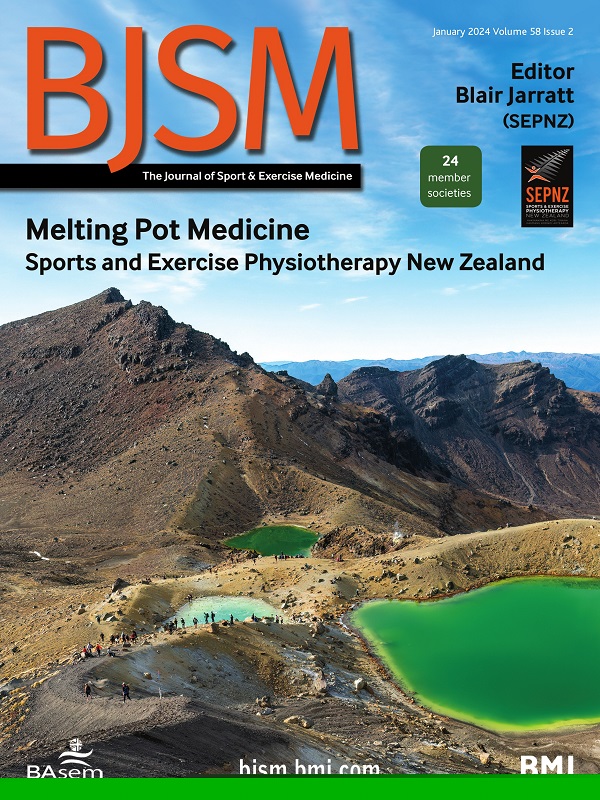Prescribing strength training for stroke recovery: a systematic review and meta-analysis of randomised controlled trials
IF 11.6
1区 医学
Q1 SPORT SCIENCES
引用次数: 0
Abstract
Objective To examine the effects of strength training on patient-important outcomes of stroke recovery and to quantify the influence of the exercise prescription on treatment effects. Design Systematic review and meta-analysis. Data sources Eight electronic databases (MEDLINE, EMBASE, EMCARE, AMED, PsycINFO, CINAHL, SPORTDiscus, and Web of Science) and two clinical trial registries (ClinicalTrials.gov and WHO International Clinical Trials Registry Platform) were searched from inception to 19 June 2024. Eligibility criteria Randomised controlled trials were eligible if they examined the effects of strength training compared with no exercise or usual care and reported at least one exercise prescription parameter. An advisory group of community members with lived experience of stroke helped inform outcomes most relevant to stroke recovery. Results Forty-two randomised trials (N=2204) were included. Overall risk of bias was high across most outcomes. Strength training improved outcomes rated as ‘critical for decision-making’ by the advisory group, including walking capacity (standardised mean difference (SMD)=0.95 (95% CI 0.34–1.56)), balance (SMD=1.13 (0.51–1.75)), functional ability and mobility (SMD=0.61 (0.09–1.14)), and habitual (mean difference (MD)=0.05 m/s (0.02–0.09)) and fast-paced walking speed (MD=0.09 m/s (0.01–0.17)), with very low to moderate certainty of evidence, mainly due to risk of bias and inconsistency. More frequent strength training, traditional strength training programmes and power-focused intensities (ie, emphasis on movement velocity) were positively associated with walking capacity, health-related quality of life and fast-paced walking speed. Conclusion Strength training alone or combined with usual care improves stroke recovery outcomes that are important for decision-making. More frequent strength training, power-focused intensities and traditional programme designs may best support stroke recovery. PROSPERO registration number CRD42023414077. Data are available upon reasonable request. All data relevant to the study are included in the article or uploaded as supplementary information. All individual study data included in this review are available directly from the original manuscripts. Any other data used for this review are available on reasonable request.针对中风康复的力量训练处方:随机对照试验的系统回顾和荟萃分析
目的 研究力量训练对中风患者重要康复结果的影响,并量化运动处方对治疗效果的影响。设计 系统综述和荟萃分析。数据来源 检索了从开始到 2024 年 6 月 19 日的八个电子数据库(MEDLINE、EMBASE、EMCARE、AMED、PsycINFO、CINAHL、SPORTDiscus 和 Web of Science)和两个临床试验登记处(ClinicalTrials.gov 和 WHO 国际临床试验登记平台)。资格标准 如果随机对照试验研究了力量训练与不做运动或常规护理相比的效果,并报告了至少一项运动处方参数,则符合资格。由具有中风生活经验的社区成员组成的顾问小组帮助了解与中风康复最相关的结果。结果 纳入了 42 项随机试验(N=2204)。大多数结果的总体偏倚风险较高。力量训练改善了咨询小组评定为 "对决策至关重要 "的结果,包括行走能力(标准化平均差 (SMD)=0.95 (95% CI 0.34-1.56))、平衡能力(SMD=1.13 (0.51-1.75))、功能能力和活动能力(SMD=0.这些证据的确定性从很低到中等不等,主要原因是存在偏倚和不一致的风险。更频繁的力量训练、传统的力量训练计划和注重力量的训练强度(即强调运动速度)与行走能力、健康相关生活质量和快步行走速度呈正相关。结论 单独进行力量训练或结合常规护理可改善中风恢复效果,这对决策非常重要。更频繁的力量训练、以力量为重点的训练强度和传统的计划设计可能是支持中风康复的最佳方法。PROSPERO 注册号:CRD42023414077。如有合理要求,可提供相关数据。所有与研究相关的数据均包含在文章中或作为补充信息上传。本综述中包含的所有单项研究数据可直接从原稿中获取。本综述使用的任何其他数据均可在合理要求下提供。
本文章由计算机程序翻译,如有差异,请以英文原文为准。
求助全文
约1分钟内获得全文
求助全文
来源期刊
CiteScore
27.10
自引率
4.90%
发文量
217
审稿时长
3-8 weeks
期刊介绍:
The British Journal of Sports Medicine (BJSM) is a dynamic platform that presents groundbreaking research, thought-provoking reviews, and meaningful discussions on sport and exercise medicine. Our focus encompasses various clinically-relevant aspects such as physiotherapy, physical therapy, and rehabilitation. With an aim to foster innovation, education, and knowledge translation, we strive to bridge the gap between research and practical implementation in the field. Our multi-media approach, including web, print, video, and audio resources, along with our active presence on social media, connects a global community of healthcare professionals dedicated to treating active individuals.

 求助内容:
求助内容: 应助结果提醒方式:
应助结果提醒方式:


